My heart thrilled at the duck-like quacking emanating from the direction of the farm-pond. Throwing open my bedroom window in spite of the 40-something nighttime temperatures, I sat perched on my bed listening in awe to the wood frogs. With rain in the forecast for later in the week, I knew I’d soon hear the voices of Spring peepers, followed by the Leopard, green and bullfrogs adding to the chorus. Joy surged within me and I was overcome with emotion. Spring had finally come to Western Maine.
Welcome to the latest Updates From the Farm! If you are new here, I invite you to check out my About page to learn what this is, who I am and why I am doing this. Or just dive right in! At “Runamuk Acres” you’ll find the recantings of one lady-farmer and tree-hugging activist from the western mountains of Maine. #foodieswanted
Amphibians and reptiles played an important role in fostering my love for wildlife at an early age. Even today, these keystone species continue to hold a special place in my heart. That’s why I’ve enrolled the Runamuk Acres Conservation Farm to serve as host for the Maine Big Night project, and I’m stoked to be able to be a part of this citizen science project!
I Love Frogs and Turtles!
As a young girl, I was the proverbial tomboy. I spent a lot of time playing outside with my younger brother. We played in the dirt making mud-pies or cakes, creating cities for his matchbox cars or digging with his Tonka trucks. We found secret forts, explored the forested landscape that surrounded our home and climbed trees.
My absolute favorite thing to do, though, was to seek out the nearest pond or wetland habitat to catch frogs, salamanders and turtles. I liked hanging out by the water’s edge watching the wriggling tadpoles. It was a treat to see a turtle sunning itself on a log. And I was forever turning over rotted logs and heavy rocks to look for salamanders. If ever we did not come when my mother called, she knew exactly where to look for my brother and I, lol.
As far back as I can remember, I’ve been fascinated by these animals. My science reports in school, were always about amphibians or reptiles. I was so taken with herpetology that I researched it extensively─even after I graduated high school. Whenever I went hiking, there was always a field guide for amphibians and reptiles in my pack. In fact, until I became obsessed with bees, amphibians were my major passion. I wanted to save the frogs.
The Problem Facing Frogs
Amphibians’ complex water-and-land life cycle makes them more vulnerable than most animals. Because of their permeable skin, frogs and salamanders are extremely sensitive to changes in their environment. Amphibian eggs have no protective shell, making them susceptible to harmful UV levels. Their mucousy skin easily absorbs harmful pollutants that might be in their watery habitats. Climate change is causing higher levels of disease among populations, while habitat encroachment results in the loss of important breeding grounds.
We’ve been watching the decline of these animals since the 1960’s. Even in protected national parks and wildlife refuges, the average population decline of amphibians is 3.97% each year. In some regions, the population loss is even more severe. Scientists predict that within the next 20 years, some species will disappear from at least half the habitats they occupy.
Note: Check out this article from the USDA to learn more about Why frog and toad populations are declining.
Why Frogs Matter
Amphibians and reptiles are important members of our aquatic and terrestrial ecosystems. They serve as both predator and prey, transferring energy between the two systems.
Viewed as indicators of wetland health, amphibians offer us an early indication of ecosystem change when monitored over long periods of time. Populations of amphibians may exhibit measurable changes in site occupancy, distribution, abundance, species richness, and increases in both disease occurrence and malformations. These changes cause a ripple effect on other aspects of the ecosystem. Predator, prey, and competitor populations, for example, as well as energy flow and nutrient recycling.
What is the Maine Big Night Project?
The Maine Big Night (MBN) is a citizen science project led by scientists and UMaine specialists. Programs like these rely on community involvement for data collection, and also provide direct relief to conservation issues. MBN seeks to identify important crossing sites, and relieve pressure from road mortality at the same time.
The project has 3 main goals:
Identify significant and vulnerable migration routes for amphibians across the state of Maine.
Provide direct relief of road mortality to local amphibian populations.
Create an opportunity for Maine citizens to participate in wildlife conservation and natural sciences.
At 286 sites throughout the state, community members can participate in the Maine Big Night project anytime between April 1st and April 30th. Participants are required to complete a brief training course and pass a quiz with a least 80% accuracy. Don’t be intimidated, though, it’s an open-book test, and you can retake the quiz as many times as needed to pass.
Once you’ve signed your liability waiver, you can adopt the site (or sites) you’d like to survey. These are 1000-foot sections of roadway which tend to encompass a wetland or forest, usually within range of a significant vernal pool.
But…What is a Big Night?
“What’s a Big Night?” the old man asked, trying to understand why I was so excited.
I was at the local post office tacking up one of my colorful flyers promoting the event.
“It’s those rainy nights in the spring when the frogs are all over the road,” I explained. “Amphibian migration.”
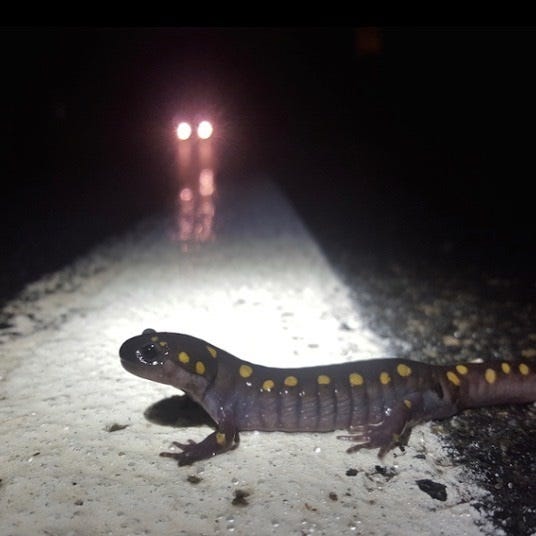
We’ve all seen it─that first “warm” rainy night in the spring, coming home late and there are frogs all over the roads… It generally happens once the ground has thawed and the nighttime temperatures are consistently above freezing. When the rains come. This is when amphibians begin migrating to breeding grounds.
A true “Big Night” is when immense numbers of migrating amphibians move simultaneously. For that to happen it needs to be around 45-degrees and rainy, though you will still see smaller numbers of amphibians moving in temperatures as low as 32-degrees.
I knew that to many of that older generation the idea would sound preposterous. I couldn’t help grinning prematurely at the reaction I expected to this next bit, “It’s a citizen science project that involves helping frogs cross the road.”
He leveled me with a look and said flatly, “You’re going to help the frogs cross the road.”
I giggled and grinned happily, “Yep! I sure am!”
The Maine Big Night Project at Runamuk
Believe me, I know it sounds ridiculous. I. Don’t. Care. I’m going to take my 17 year-old son out after supper some night in April─along with whomever else I can convince to join me. We’re going to put on reflective vests and headlamps, set our cars along the roadside with 4-way flashers blinking in the night, and stand out in the rain to help frogs and salamanders safely reach their breeding grounds.
The Maine Big Night program has even put together a playlist on Spotify, featuring songs like: Jeremiah was a Bullfrog, Chasing Cars, Big Night and Have You Ever Seen the Rain, to name a few. Damn straight I’m gonna make a party of it!
Personally, I don’t feel good about running over frogs on the road. I never have.
I just can’t imagine a world without frogs or salamanders. The MBN project is one small way I can help. Plus, it’s a great way to get kids and families engaged in natural science and community involvement. How could that be a bad thing?
With that goal in mind, I’ve enrolled Runamuk to serve as a host organization for MBN volunteers in this part of the state. This means certified participants can sign-out safety gear, data sheets, and ID card for free at Runamuk Acres. I just have to have the materials back by May 30th so I can send them back to the University of Maine.
Greg LeClair, Project Coordinator, told me that Runamuk is the northernmost organization to participate in the Maine Big Night project. There’s a real need for data collection in this part of the state, so that we can know that status of amphibian populations in the Kennebec River and Western Maine regions. Once we know what we’ve got, then we can begin monitoring those populations, and monitoring the health of the ecosystems they represent.
If you’re a Maine resident interested in becoming a volunteer click here to go to to the Maine Big Night homepage for more info. OR click here to go directly to the Volunteer Materials & Training page.
Anyone local to the Runamuk Acres Conservation Farm is welcome to join us on the farm for Big Night, or come see us to borrow materials for your own Big Night! Contact the farm directly for more information.
This year, BraeTek and I will be scouting sites in the area to determine which locations most need help, but we’re also going to be monitoring the farm’s very own pond, right alongside School Street here in New Portland. Locals are invited to join Maine Big Night at Runamuk, OR you can work independently to create your own MBN adventure. I sincerely hope you will.
Much love to you and yours, my friends!
Your friendly neighborhood farmer,
Sam
Thank you for following along with the story of this lady-farmer! It is truly a privilege to live this life serving my family and community, and protecting wildlife through agricultural conservation. Check back soon for more updates from the farm, and be sure to follow @RunamukAcres on Instagram or Facebook!




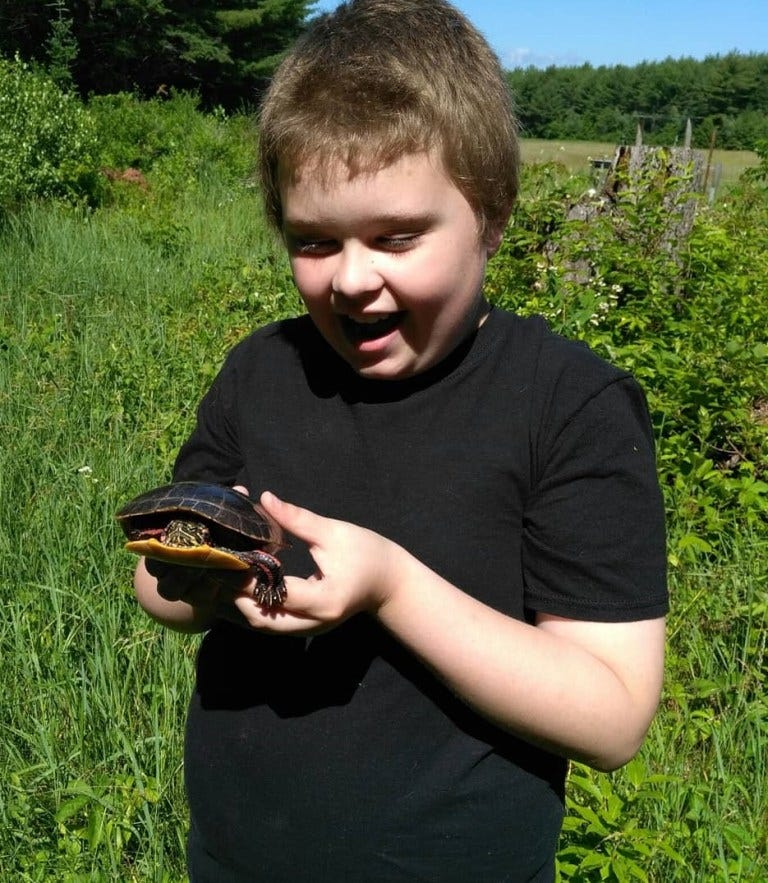
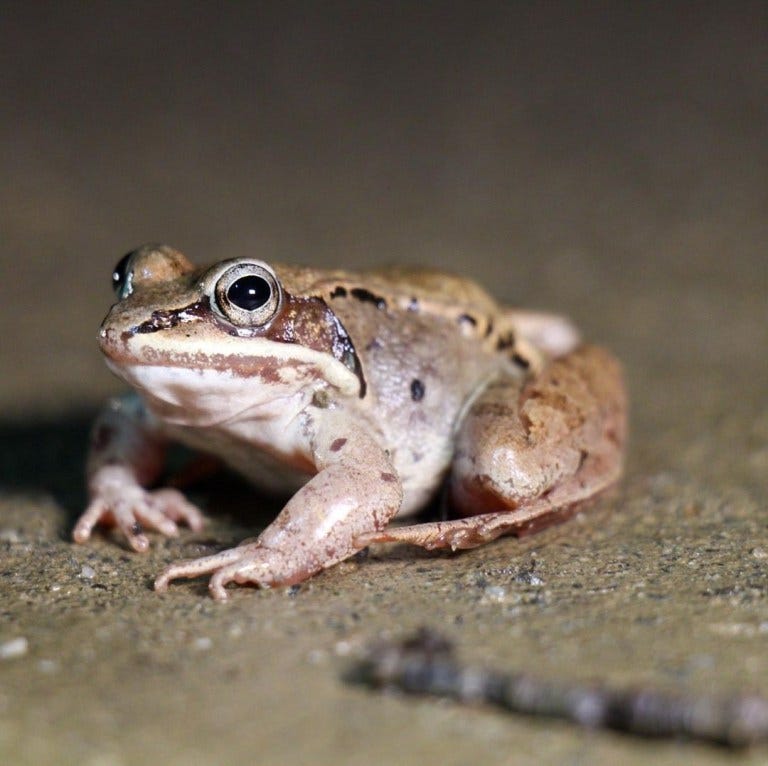
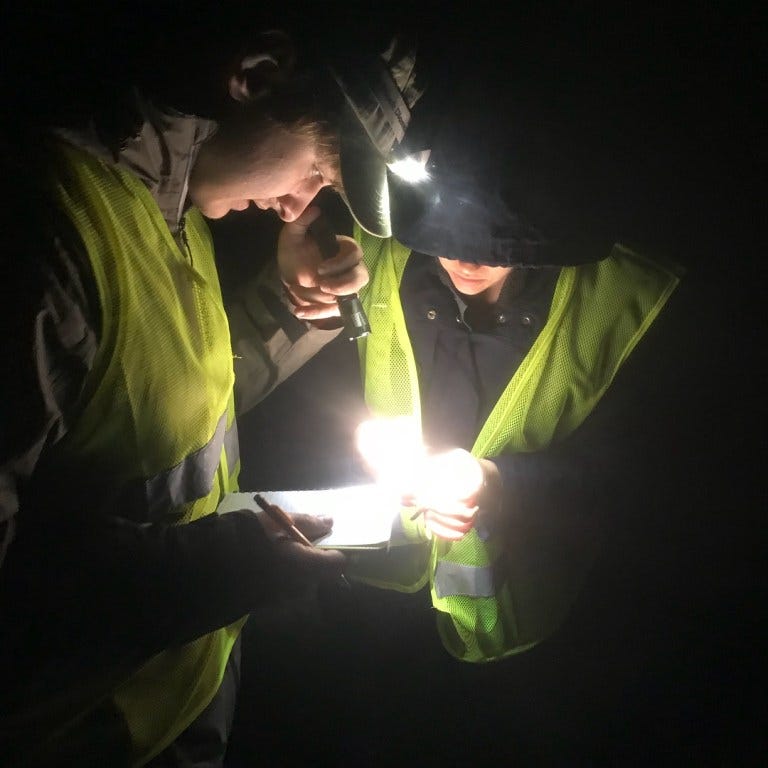
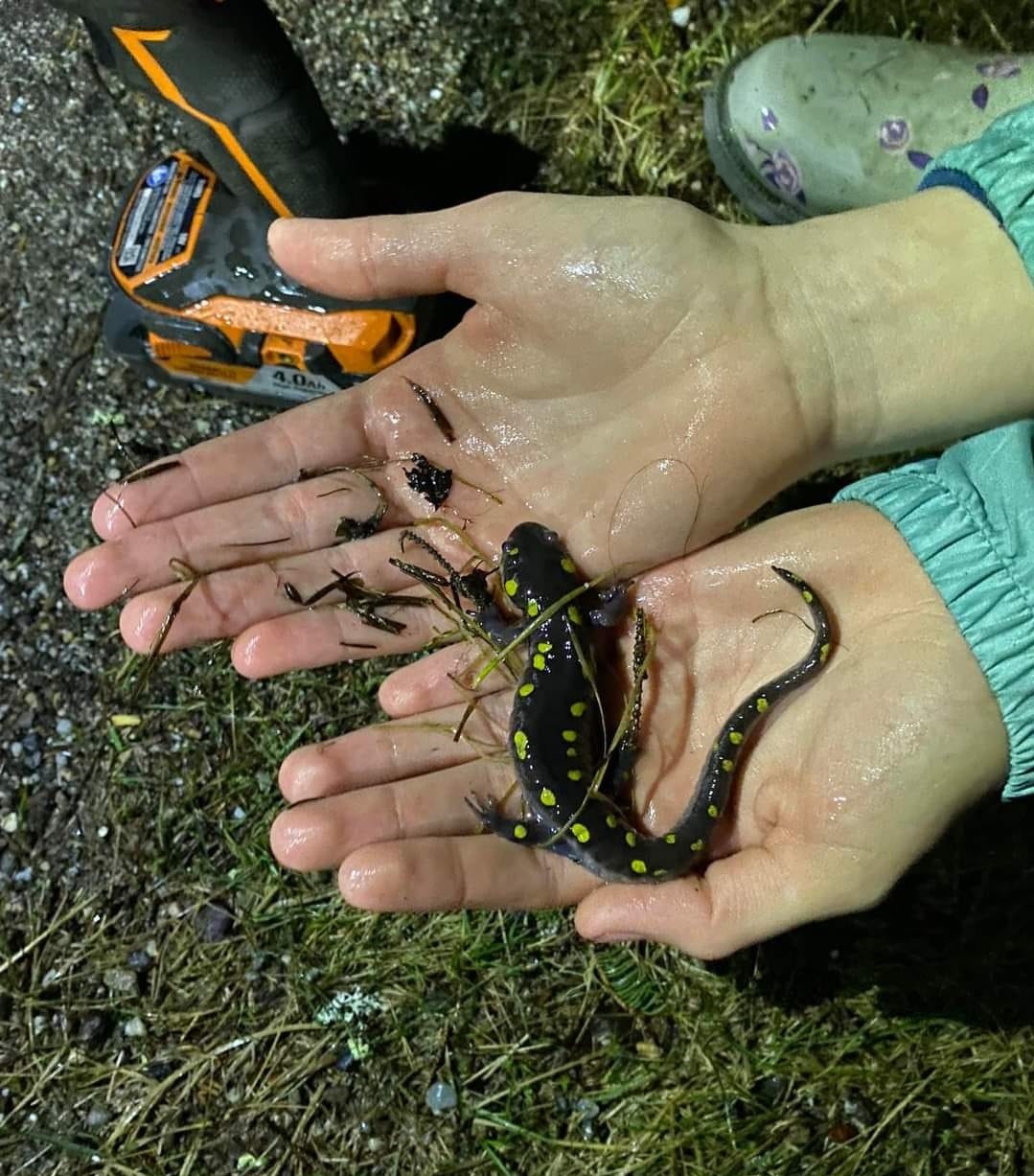
Universal finding tadpoles, toads and amphibians in fox holes by pussy-willow catkins dropping and bees pollinating. Then industrial waste and acid rain came. Destruction of bogs and fire flies declined to humanity’s shortsighted view of life not seen by forgotten children eyes of happiness.
Every insect large or small and bird or frog has a place. Humans run amuck as you know and your senses tell you to change the world to one of peaceful coexistence. You are one hopefully among many more to follow a natural path to enlightenment.
I love this! I totally get it. I can’t tell you how many turtles I’ve rescued from local roads.